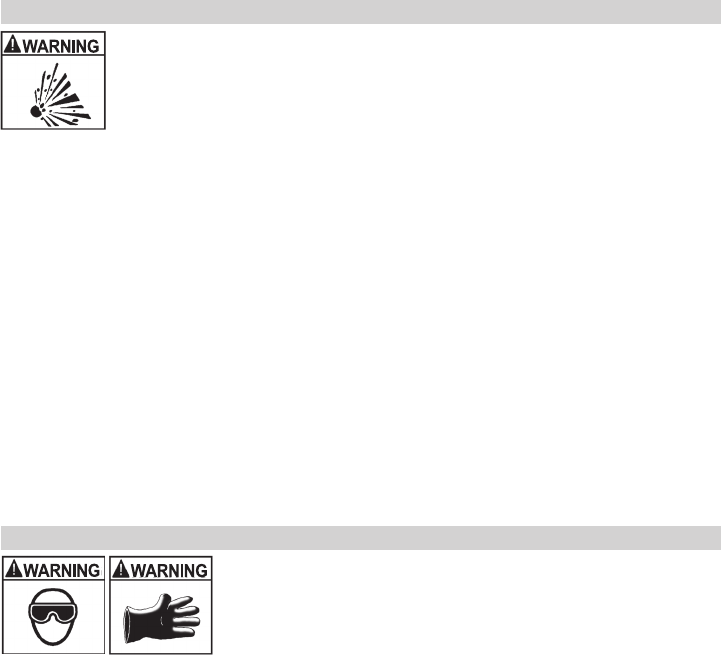
• 3 •
1.11 To reduce the risk of a battery explosion, follow these instructions and those published by
the battery manufacturer and the manufacturer of any equipment you intend to use in the
vicinity of the battery. Review the cautionary markings on these products and on the engine.
1.12 This charger employs parts, such as switches and circuit breakers, that tend to produce
arcs and sparks. If used in a garage, locate this charger 18 inches (46 cm) or more
above oor level.
2. PERSONAL PRECAUTIONS
RISK OF EXPLOSIVE GASES.
2.1 NEVER smoke or allow a spark or ame in the vicinity of a battery or engine.
2.2 Remove personal metal items such as rings, bracelets, necklaces and
watches when working with a lead-acid battery. A lead-acid battery can produce
a short-circuit current high enough to weld a ring or the like to metal, causing a
severe burn.
2.3 Be extra cautious, to reduce the risk of dropping a metal tool onto the battery. It might
spark or short-circuit the battery or other electrical part that may cause an explosion.
2.4 Use this charger for charging LEAD-ACID batteries only. It is not intended to supply power
to a low voltage electrical system other than in a starter-motor application. Do not use
this battery charger for charging dry-cell batteries that are commonly used with home
appliances. These batteries may burst and cause injury to persons and damage to property.
2.5 NEVER charge a frozen battery.
2.6 Consider having someone nearby to come to your aid when you work near a
lead-acid battery.
2.7 Have plenty of fresh water and soap nearby, in case battery acid contacts your skin,
clothing or eyes.
2.8 Wear complete eye and body protection, including safety goggles and protective
clothing. Avoid touching your eyes while working near the battery.
2.9 If battery acid contacts your skin or clothing, immediately wash the area with soap and
water. If acid enters your eye, immediately ood the eye with cold running water for at
least 10 minutes and get medical attention right away.
2.10 If battery acid is accidentally swallowed, drink milk, the whites of eggs or water. DO NOT
induce vomiting. Seek medical attention immediately.
3. PREPARING TO CHARGE
RISK OF CONTACT WITH BATTERY ACID. BATTERY ACID IS A
HIGHLY CORROSIVE SULFURIC ACID.
3.1 If it is necessary to remove the battery from the vehicle to
charge it, always remove the grounded terminal rst. Make sure all
of the accessories in the vehicle are off to prevent arcing.
3.2 Be sure the area around the battery is well-ventilated while the battery is being charged.
3.3 Clean the battery terminals before charging the battery. During cleaning, keep airborne
corrosion from coming into contact with your eyes, nose and mouth. Use baking soda
and water to neutralize the battery acid and help eliminate airborne corrosion. Do not
touch your eyes, nose or mouth.
3.4 Add distilled water to each cell until the battery acid reaches the level specied by the
battery manufacturer. Do not overll. For a battery without removable cell caps, such
as valve regulated lead acid batteries (VRLA), carefully follow the manufacturer’s
recharging instructions.
3.5 Read, understand and follow all instructions for the charger, battery, vehicle and any
equipment used near the battery and charger. Study all of the battery manufacturer’s
specic precautions while charging and recommended rates of charge.
3.6 Determine the voltage of the battery by referring to the vehicle owner’s manual and
make sure that the output voltage selector switch is set to the correct voltage. If the
charger has an adjustable charge rate, charge the battery in the lowest rate rst.
3.7 Make sure that the charger cable clips make tight connections.


















